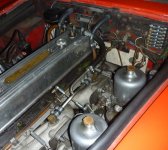As we know, PCV stands for Positive Crankcase Ventilation. Our cars already have this. The excess crankcase pressure is vented back to the air intake as a pollution control mechanism. Previously it was vented to atmosphere in the car's slipstream. My question is, what is the purpose of adding the PCV Valve? I understand that its main purpose is to prevent blow back, what other function does it perform? I also read that constant depression carburettors such as SUs already prevent blowback occurring.
A good question, and good explanations here:
https://auto.howstuffworks.com/positive-crankcase-ventilation-system.htm
and here:
https://en.wikipedia.org/wiki/Crankcase_ventilation_system
What the 6-cyl Healeys have--the 4-cyls have draft tubes--cannot be considered 'positive' crankcase ventilation (I've always thought 'positive' was a bit of a misnomer since a vacuum; i.e. 'negative' air pressure is used, but never mind). I believe--though neither of these articles state it outright--is that the term 'positive' is used because air is circulated through the crankcase and into the intake manifold in a controlled, regulated fashion. To me, a better term would be 'active crankcase ventilation' instead of PCV, whereas the draft tube and vent to the carburettor could be considered 'passive crankcase ventilation' but, again, never mind.
The difference between PCV and the draft tube/carb vent approaches is that in a PCV system fresh air is mixed with the blow-by gasses to aid in combustion of the gasses. As I wrote earlier, a true PCV system has a filtered fresh air intake, either on the valve cover(s) or behind the air filter atop the carburettor. The PCV valve minimizes the air/blow-by flow at idle, when it basically acts as an intake leak, but the valve opens up under more open throttle conditions, when blow-by is greater and the additional mixture (mostly air) is inconsequential. Also as I wrote earlier, installing a PCV valve on a Big Healey does not a PCV system make (unless you add a source for filtered air). We are using the PCV valve to pull a vacuum on the crankcase, which for my car created a) lower oil consumption/loss and b) less blue smoke on acceleration after extended high-vacuum conditions (long downhill coasts in gear).
I can't think of any reason why constant depression--aka 'variable venturi'--carburettors would prevent 'blowback' any more than a fixed venturi carb. A variable venturi carb, like an SU, is just a different--IMO superior, and certainly more elegant and simple--method of mixing fuel and air. Both types of carburettors produce a vacuum--'depression' to non-American speakers--in the intake manifold, and downstream of the throttle plates there is no significant difference. BTW, I'm old enough to remember when PCV systems were first required on American cars, and there was a huge controversy. As with catalytic converters, the car companies and 'car guys' complained furiously but--except for early cats which were defective--both have had largely, ahem, positive outcomes. As an aside, don't some Brit cars--like later MGBs--have an 'air pump?' I don't know the theory, but it sounds like the idea is to force air through the crankcase, in which case 'positive' crankcase ventilation would be the appropriate term.
Learned some interesting trivia: "During
World War II a different type of crankcase ventilation had to be invented to allow
tank engines to operate during deep
fording operations, where the normal draft tube ventilator would have allowed water to enter the crankcase and destroy the engine.[SUP]
[4][/SUP] The PCV system and its control valve were invented to meet this need, but no need for it on automobiles was recognized." - Wikipedia article


 Hey there Guest!
Hey there Guest!
 smilie in place of the real @
smilie in place of the real @
 Pretty Please - add it to our Events forum(s) and add to the calendar! >>
Pretty Please - add it to our Events forum(s) and add to the calendar! >> 



 A friendly reminder - be careful what links you click on here. If a link is posted by someone you don't know, or the URL looks fishy, DON'T CLICK. Spammers sometimes post links that lead to sites that can infect your computer, so be mindful what you click.
A friendly reminder - be careful what links you click on here. If a link is posted by someone you don't know, or the URL looks fishy, DON'T CLICK. Spammers sometimes post links that lead to sites that can infect your computer, so be mindful what you click.